Welcome to Part 2 of the School of Golf Architecture. For an introduction to the series, check out the first installment.
The latest School of Golf Architecture podcast, featuring a discussion with George Waters about linksland, is below. Give it a listen, or continue reading, or try both!
Opening thoughts
Varied ground. Sandy hazards. Closely cropped turf, sometimes bordered by longer grasses or shrubs. The basic components of a golf course weren’t theorized in the abstract, agreed upon by some committee. Instead, they were invented by the terrain itself. That terrain was linksland.
For a long time, golf and the linksland were inextricable. But as the game grew more popular, it moved inland. The courses built on the heathlands and parklands of England, Europe, and the United States emulated—sometimes successfully, sometimes less so—features that occurred naturally on the seaside links. Contours, bunkers, fairways, roughs. The linksland, in other words, was the first and most influential golf architect.
So in this second installment of the School of Golf Architecture, we turn our attention to sandy coastal terrain and learn what we can from it.
Linksland begins with a collision between sea and rock, which creates sand. Strong winds move the sand and disperse it into beaches. When grains of sand run into obstacles, they come to rest in hummocks. The longer these nascent landforms survive, the more vegetation they can support. Turf grasses like bent or fescue take hold. The rumpled topography becomes stronger, more fixed in place, and a golf-friendly system of sand dunes may emerge.
I lifted this narrative from a book called Sand and Golf: How Terrain Shapes the Game. It’s a study of sandy, windy landscapes—how they gave rise to golf and how they might continue to inspire golf course design. The book’s author, George Waters, has spent years walking and examining the links, caddying at Royal Dornoch and working on sandy sites at Barnbougle Dunes and Pinehurst No. 2. He’s currently the Manager of Green Section Education for the USGA, and his writing can be found on USGA.org and in the USGA Green Section Record.
Today, he’s my teacher. Our subject is the linksland.
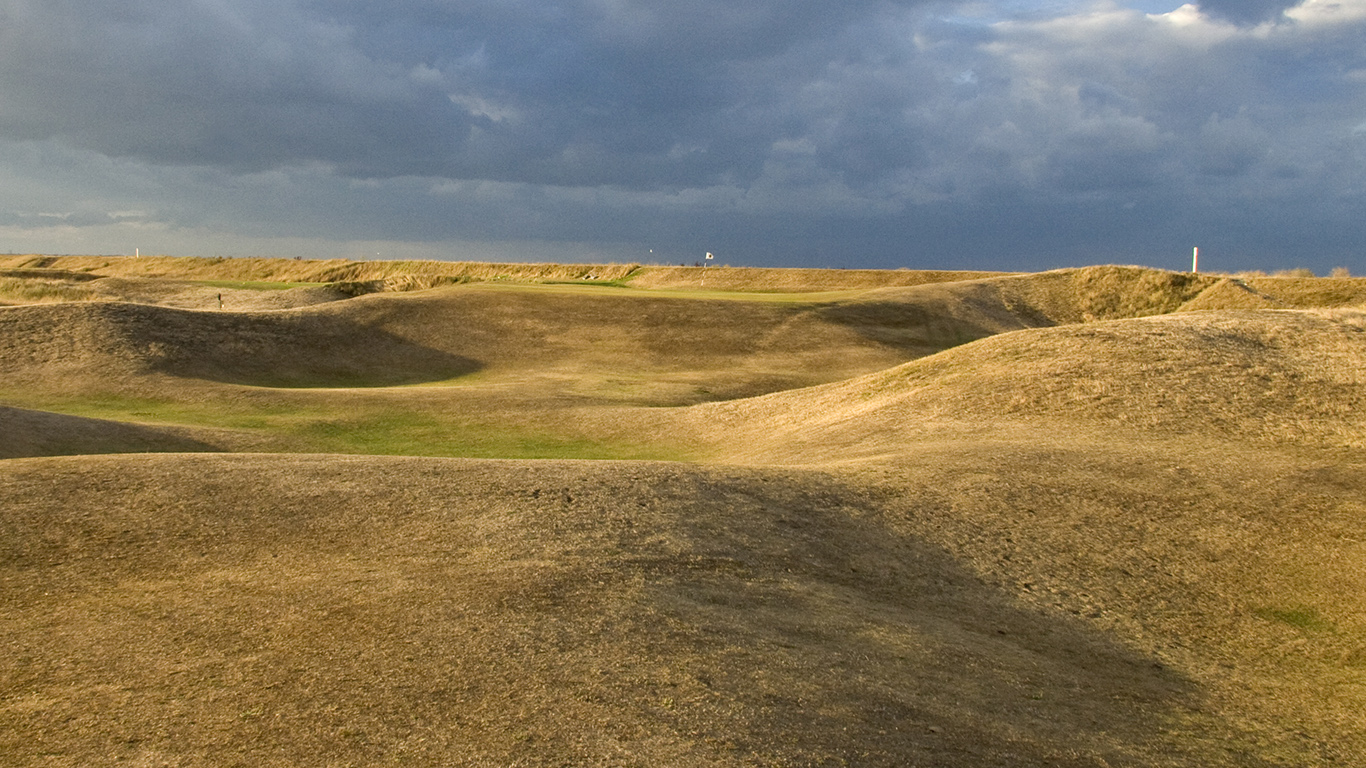
The roller-coaster approach to the 6th green at Royal Cinque Ports (Deal). Photo credit: George Waters
Highlights from the interview with George Waters
On the randomness of links terrain:
That was something that struck me about spending a lot of time studying links golf courses: an awful lot of features are just there because they’re there, and there’s not really a rhyme or reason or necessarily a structure to it. That element of randomness and the willingness-slash-inability to modify that, the willingness to embrace it and the inability to wipe it away, created this sort of—you’ve heard the term “infinite variety.” Well, those courses have it because there’s just so much going on in terms of topography, in terms of hazard location, the nature of the hazards. And that element of randomness is hard to build. It’s hard to create it. And mother nature is really good at just leaving these sort of—I think Bob Ross called them these “happy little accidents.”
On how the drainage capabilities of sandy soil allow golf architects to keep aggressive contouring intact:
Drainage allows you to be a lot more free with what the landscape offers because you don’t need to worry about draining every little wrinkle and pocket. The other side of that is grading everything out so that everything surface-flows smoothly across a hollow, into a basin, whatever it might be. Which quickly gives a landscape a manipulated look to it. When you need to start doing all that grading, it’s hard to make it look like you never did anything. So being able to take the site as it is because of the drainage is really beneficial.
On wind and firm turf making ground contour relevant:
The fact that your ball is going to move a lot—the inevitable movement of your ball, either as a result of the wind or as a result of the contour—it’s going to be a very different thought process than the kind of yardage golf that you find to be much more common in most of the United States and on most inland sites. Once you have to start thinking about the rollout of the ball after it lands, you find yourself studying a lot more of the contours because they’re relevant, as opposed to if you’re hitting to a yardage in the middle of the green.
Like the contouring that’s in the approach and around the green: you might be aware of it from a visual standpoint, or something might look cool. But if it’s not really a factor in the shot, it’s not going to weigh into your mind so much. It’s kind of window dressing as you’re hitting over it—at least in your mind’s eye, as far as the planned shot.
On why links courses often have hazards in the approaches well short of the green:
Rather than being kind of right up against the front of the green, they’re going to be 20 yards, 40 yards short. If you look at those on an aerial or Google Earth, if you’re not totally familiar with playing golf in those kinds of courses, [the hazards] seem like they’re out of play. Why is there a bunker 30 or 40 yards short of the green? Why are there so many of them like that? And the reason is it becomes a real issue for playing those running approach shots, where you need to kind of just hurdle the approach hazard and have it run out and reach the green.
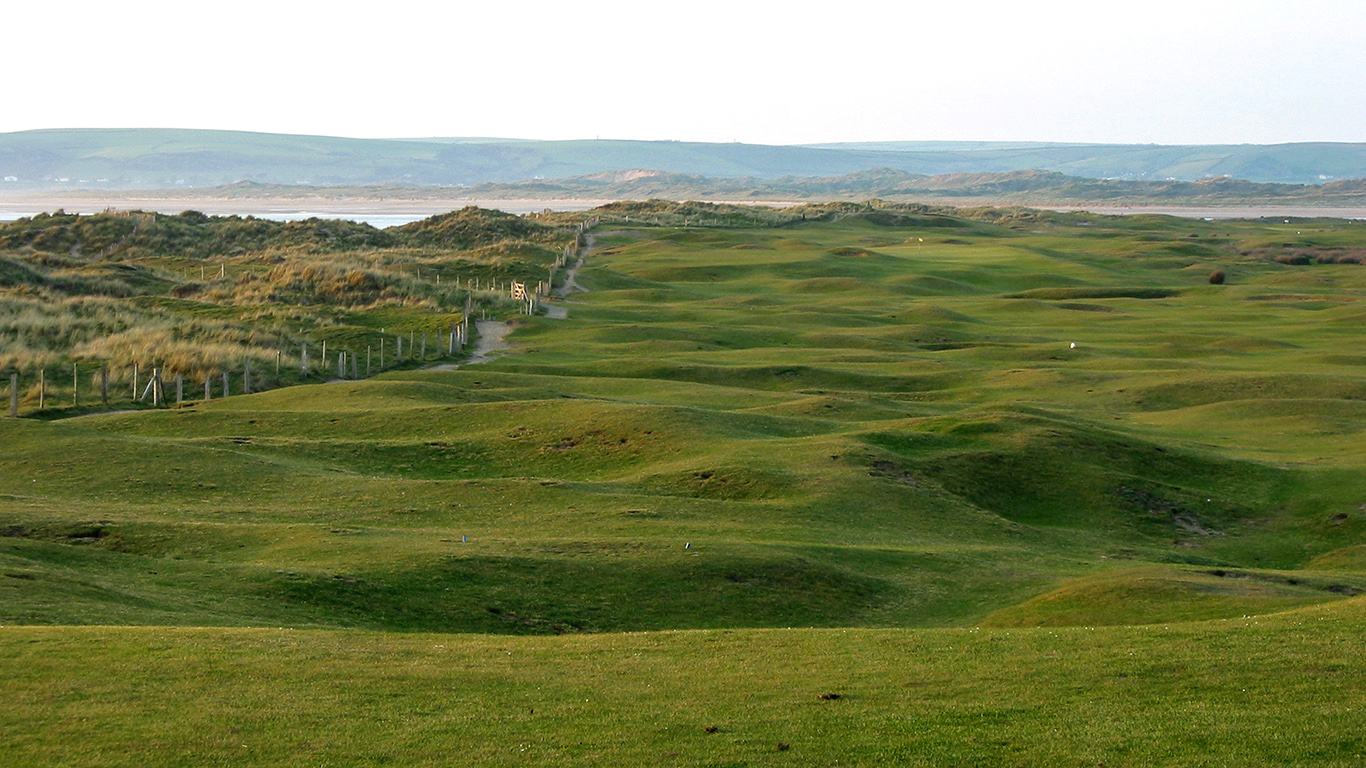
The innumerable "happy little accidents" at Royal North Devon (Westward Ho!). Photo credit: George Waters
On the uselessness of a yardage guide at Royal Dornoch:
When I first got to Dornoch, I bought a yardage guide. I figured, well, this is going to be an invaluable resource out here. And what I learned pretty quickly was that studying the course in plan view, aside from getting to know the basic locations of the hazards, wasn’t very useful. And knowing the yardage from different points was not terribly useful because the wind was so different all the time and the firmness of the ground was variable. It really just becomes a study of the landscape, a study of the contours, and a learning process of how shots react off of different features.
On the tendencies of golf architecture on less suitable sites:
As time went on, and as our ability to manipulate the landscape increased continually—as our ability to do so affordably increased—you saw less regard for site suitability, I would say, and more of a focus on, okay, we want the golf course here. We’re doing a development and we can fix whatever. There is no landscape we can’t turn into a golf course, regardless of what’s naturally there, whether it’s a swamp, whether it’s rock, whether it’s super hilly. There was certainly a belief that nothing was out of the realm of possibility.
And I think as we’ve seen down the road, while there are examples of exceptional courses that have been built on really difficult sites, there are some limits to that. And certainly the skill of the architect is going to be a big factor. [But] there are only so many possibilities within a person’s own mind for what you can manufacture versus what’s suggested to you by the natural landscape. Well, if the natural landscape is unsuitable for what you’re trying to do, those cues aren’t going to be there. So you often get a formulaic result, where it’s just, okay, we’re doing this again, regardless of what’s there.
On how golf can help restore links landscapes that have been degraded:
You see places like Oregon, where gorse was introduced to stabilize those dunes back in the day because the blowing sand was seen as a nuisance, not as a cool aspect of coastal dune environments. So in the process of building Bandon Dunes, you’re removing a lot of that invasive vegetation. You’re taking steps to preserve and maintain these more natural environments.
And I think you see more and more of that now on links courses in the UK and Ireland and over here. They’re making more of an effort to remove the symptoms of that stability, get some more moving sand in the landscape, increase the ecological value, bring back the elements of the course that would have been there in a more dynamic time. So I think as we look at it going forward, you’re going to see more golf courses actually helping to restore and preserve what would have been lost otherwise.
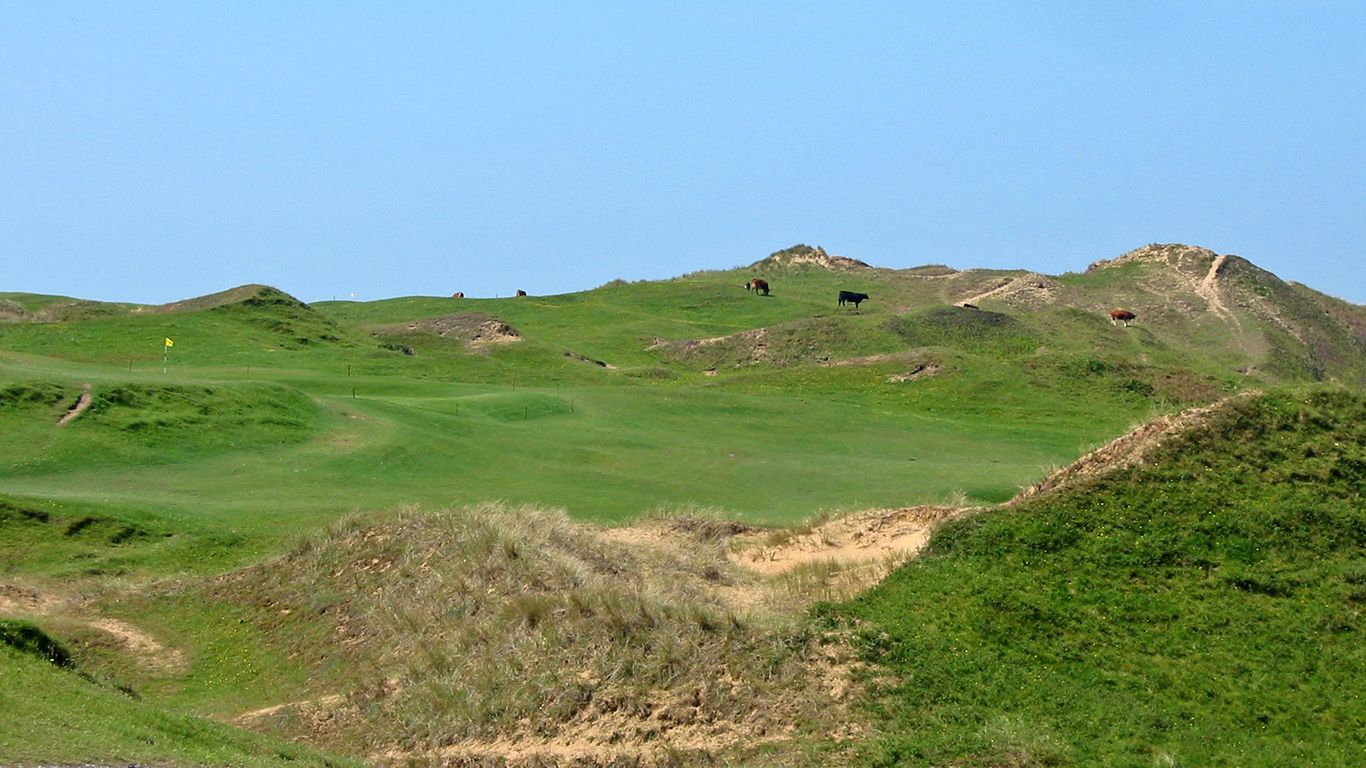
Cattle grazing the Welsh links of Pennard. Photo credit: George Waters
Closing thoughts
The subtitle of George’s book Sand and Golf is “How Terrain Shapes the Game.” In talking with him, I began to understand more fully what that phrase means.
The linksland wasn’t just an initial arena for our stick-and-ball pastime. It defined golf. It gave the sport an ethos: not just golfer versus golfer, but both of them versus nature. An ethos of local pride rooted in unique landscapes. An ethos of the unpredictable, the creative, the adventurous.
Here’s how George puts it in the epilogue of Sand and Golf:
“Sandy terrain allows golfers of all ages and abilities to enjoy the game in their own way, making it much easier for the game to grow and play a lasting role in people’s lives. Golf on sandy terrain can be extremely challenging, but mostly it is about fun and creativity, studying the landscape, coping with the bad bounces, and relishing the good ones. It is about enjoying a golf course as part of nature, complete with irregularities and imperfections. Rather than detracting from the experience, those imperfections make the game more interesting, and somehow more real.”
As golf migrated away from the linksland, golfers often forgot these pains and pleasures, along with the temperament needed to receive both. Again, terrain shapes the game. And when the terrain is softer and and more regular, our ideas about the sport we play on it shift accordingly. We expect help from the ground and from those who shape and maintain it. We ask for a “fair” test of skill. (Which skill?)
There are those who enjoy this version of golf, and of course there’s nothing wrong with that. But there are also those who find the linksland and its ethos irresistible. I’m among them. The problem is, not many of us live by the sea, or by inland sand hills, or anywhere near a course that uses sandy terrain to full advantage. So I leave you with this question: if we so desire, what can we do, and what can our local courses do, to recapture some of the character of links golf?
I actually posed a version of this question to George. I cut his excellent answer from the podcast but have included it in the “Extras” section below. Got thoughts of your own on the subject? Come see us on Twitter: @the_fried_egg, @gfordgolf (that’s me), and @gwatersgolf (that’s George). Let’s keep the discussion going.
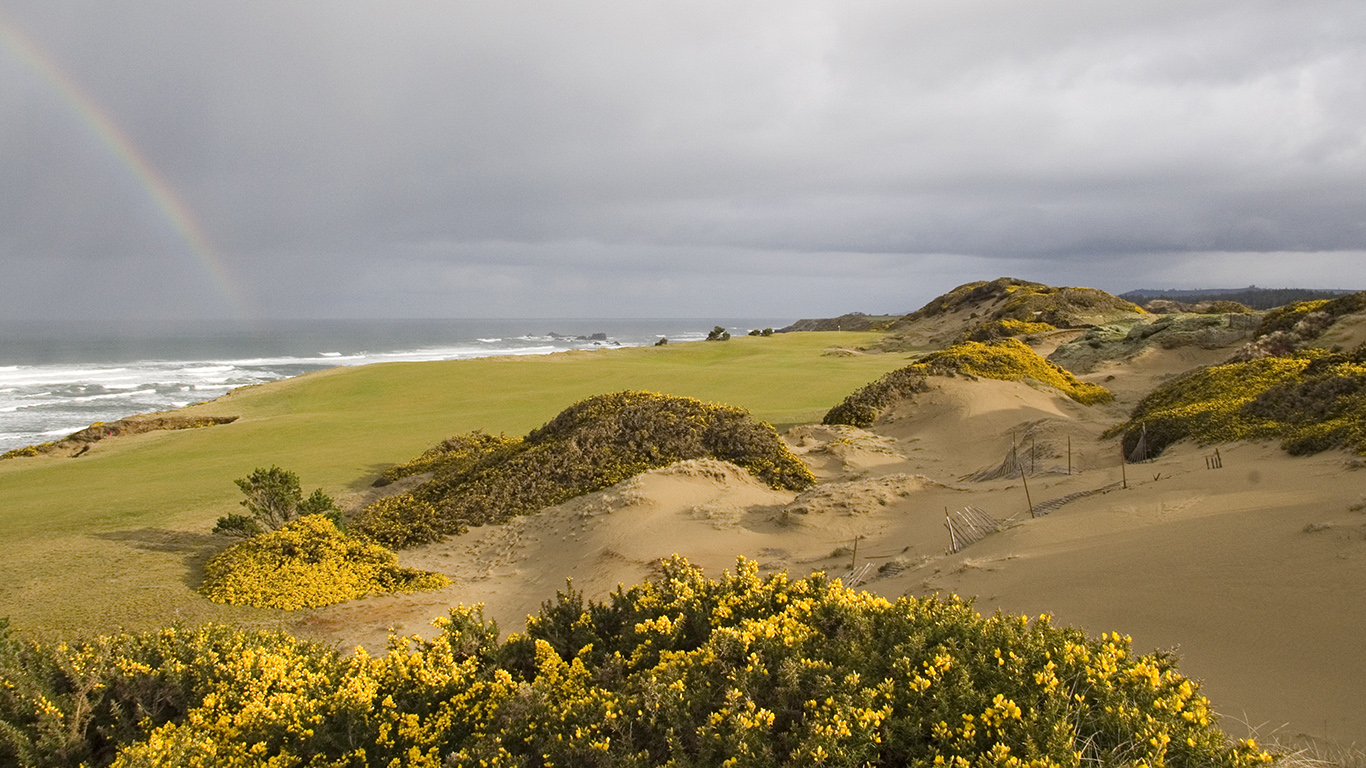
Blooming gorse and exposed sand on the 13th hole at Pacific Dunes. Photo credit: George Waters
Further exploration
George Waters, Sand and Golf: How Terrain Shapes the Game (2013)—This beautifully presented volume serves not only as a textbook on golf terrain and a brief in support of sand-based sites, but also as an introduction to the basic principles of golf architecture.
I would also recommend George’s writing for the USGA website:
- Rethinking Bunker Maintenance: Embracing the Imperfections
- How Naturalized Areas Benefit Golf Courses of All Types
- Perfectly Imperfect: The Sandscapes of Pinehurst Number 2
Horace Hutchinson, Famous Golf Links (1891)—One of the earliest literary tours of the United Kingdom’s links. The profiles of St. Andrews, Sandwich, and Machrihanish give a vivid portrait of an era when seaside golfing grounds were more natural and less stable.
Bernard Darwin, The Golf Courses of the British Isles (1910)—Still the ultimate compendium of links (and heathland) courses, and perhaps the greatest golf book of all.
Michael Bamberger, To the Linksland: A Golfing Adventure (1992)—This travelogue does not focus on course design and is not solely about links golf, but it conveys the centrality of the linksland to a golfer’s soul.
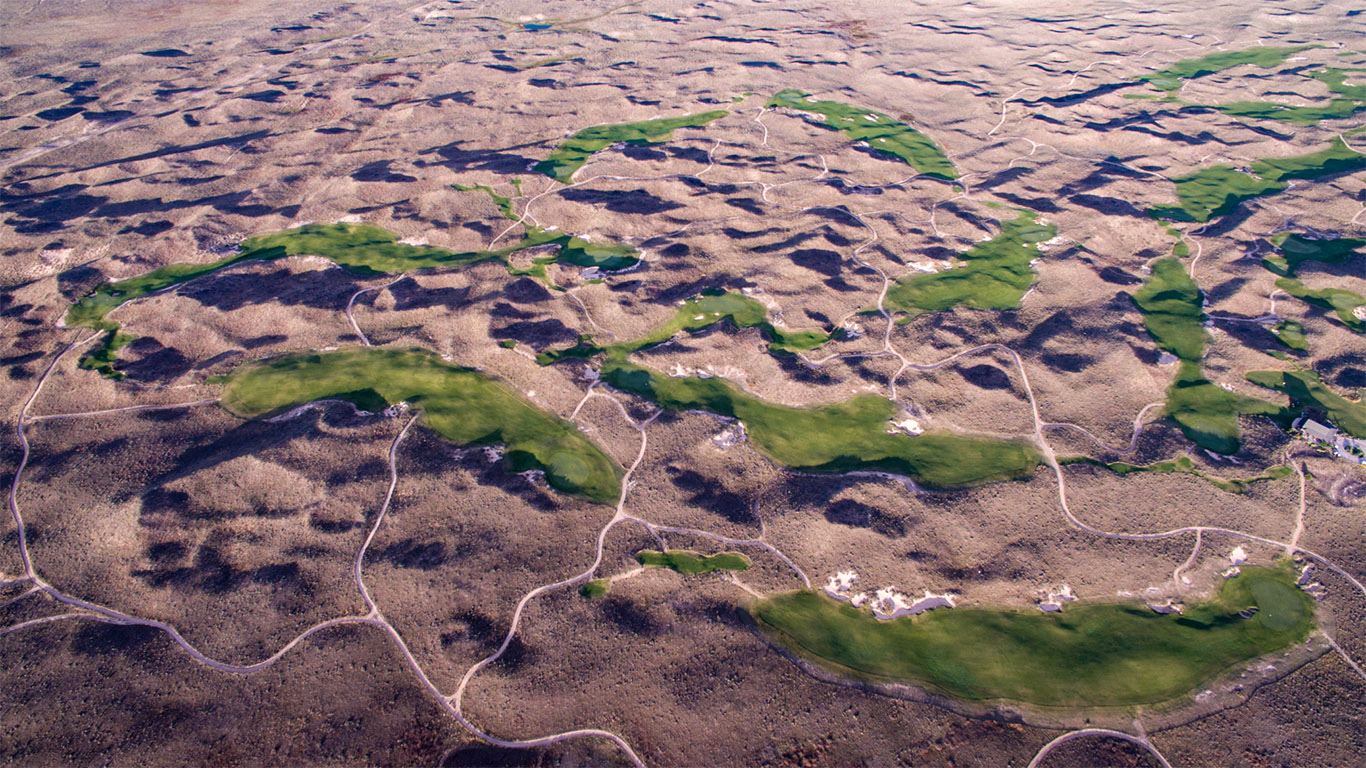
The sandy chop hills of Ballyneal. Photo credit: Andy Johnson
Extras
On exporting the playing characteristics of the linksland to non-sandy sites:
Garrett: We’ve talked a lot about the value of firm conditions on sandy ground, but the vast majority of places don’t necessarily have sandy ground available. Can courses in those areas emulate the kinds of conditions and strategic interest that we’ve been discussing?
George: The answer is yes, but there are a lot of factors involved and almost any approach is going to involve some costs. On the high end, there are certainly courses that have greatly improved their firmness by installing fairway drainage, sand capping, or doing a lot of topdressing in fairways and surrounds. Cal Club, for example, is not on great soils, but it plays really firm. That’s because they invested in fairway drainage and sand blending during the restoration and planted grasses that could handle drier conditions. They also put a big emphasis on water management and devote a lot of staff time to it.
Not every course can do those things. But I’ve also seen great firm conditions on courses with really limited budgets, often a product of the fact that they don’t have the staff or the irrigation system to do much else. I think those courses can play great, but there are definitely going to be some bare spots and scruffy areas as a result. That kind of thing doesn’t bother me personally all that much, but courses have to listen to their customers and some golfers definitely complain about things like that.
That’s where there is definitely an education element to firm conditions. It’s not something where places can just flip a switch and start watering less. Grass types, climate, cart traffic, and golfer expectations are just a few of the factors involved in how firm a course can play. Context also matters. If you’re surrounded by lush green courses, it’s hard to be the first one in the neighborhood to put out a different product. Bandon works because all the courses look and play in that great linksy way, so it’s a consistent experience. If you had one course presented like that in a different neighborhood, it would be interesting to see how people would react. I mean, I’d go play it, but that’s me.
With all that said, I think it’s really worth making the effort to educate golfers about the benefits of firmer conditions, just from the standpoint of it making golf more fun, more interesting, and more enjoyable for more people. Some places are also going to have to start watering less whether they like it or not because of water restrictions. There are certainly some mountains to climb on the way in terms of changing expectations, but to me I think it’s worth making the effort. I also get that some people just don’t want firm conditions, and that some courses weren’t designed to accommodate firm conditions, and that’s fine too.
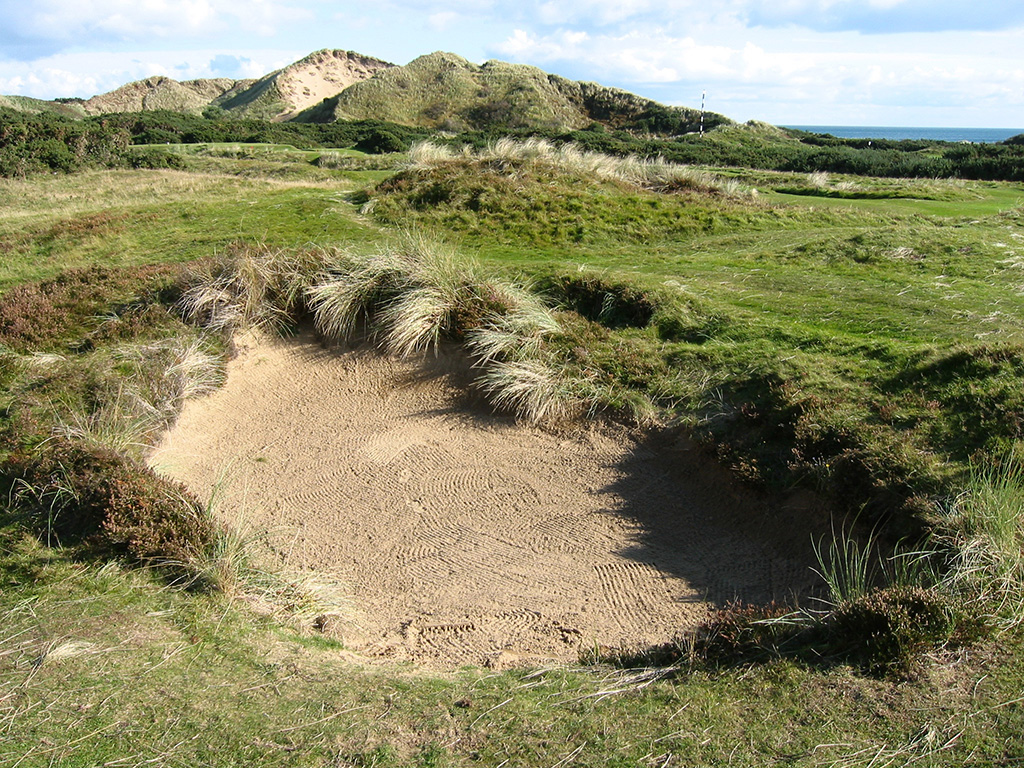
A typically fierce bunker at Royal County Down. Photo credit: George Waters
On links hazards:
Garrett: What’s distinctive about hazards on sandy ground?
George: When you see these old hazards on the links courses, they were literally eroded areas of sand that just kind of naturally occurred. And obviously nobody was raking them and nobody was really tending to them. So they were rough and rugged. You weren’t expecting to have a good lie. You weren’t expecting necessarily to be able to hit a shot in the direction of the flag, or even the direction of the green.
And I think that way of looking at a hazard has persisted. Now, links bunkers have obviously been cleaned up to quite a degree. But in those revetted bunkers, you get into all of these bad corners and awkward spots and, and a big part of playing links golf is being prepared to take your medicine sometimes.
You get the value of thinking your way through a problem that isn’t necessarily found if the bunkers are “fair,” where everything gathers to the middle and everything is as clean and consistent as possible. Then bunker play becomes less of a thought process and more of just an execution. Are you practicing sand shots? If you end up in the middle of a bunker, you’re going to be able to replicate that shot. Whereas with links and heathland bunkers—more rugged, unpredictable hazards—you need to be able to hit more bunker shots, shots from bad lies, shots with one foot out, one foot in.
Also, the fear factor of a bunker really increases with unpredictability. If you don’t know what you’re going to get when you go in a bunker, you’re that much more keen to avoid them. And the more you’re thinking about avoiding them, the more you’re starting to look at these other areas of the course, and thinking, where do I want to miss more? There’s just a lot more to think about.
The other part of it—and this is to varying degrees—but it’s great when places will just use the natural sand. I’ve been disappointed a bunch of times to visit sandy sites and find that they purchase bunker sand and bring it in from somewhere else because people complain about the inconsistency of the sand, or that there’s pebbles in the sand, or whatever it might be. I think it adds character when places use the natural sand. And the more natural bunkers can be, the less consistent they will be, and the more value they will have as a hazard.
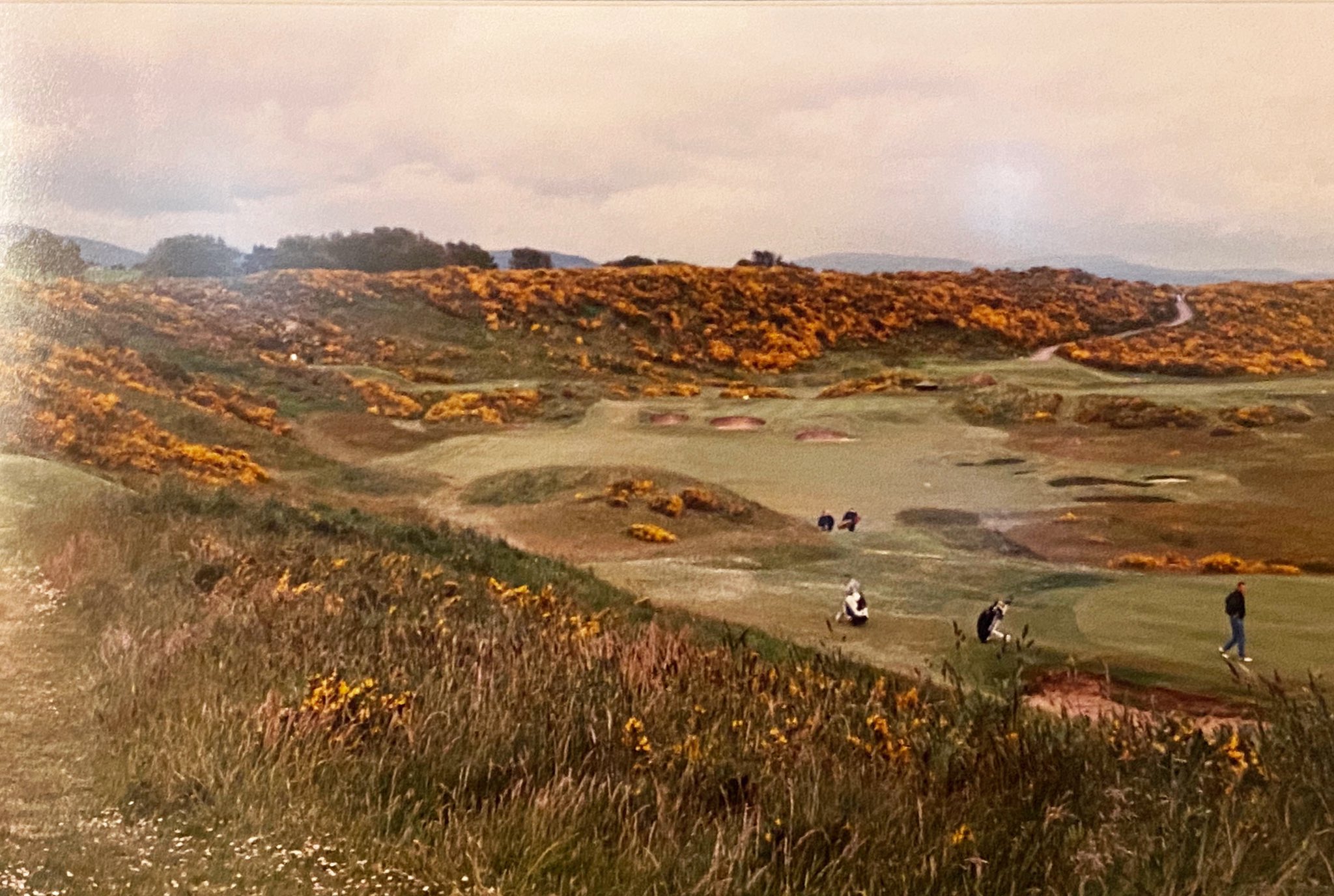
Royal Dornoch in 1999, captured with a film camera. Photo credit: George Waters
tGarrett: And the rough tends to be different on sandy terrain as well.
George: There’s an interesting variety there, too, but I would say that in general the rough tends to be more sparse and, again, more inconsistent. Links courses are not trying to over-irrigate their rough. And they’re certainly not trying to fertilize it. In most cases, they don’t want rough to be lush—at least in the best managed examples of sandy golf. So you get sparse, tufty rough as opposed to this uniform carpet of denser rough that, on heavier soils, is just kind of an inevitability.
A cool thing about that more imperfect rough is that, again, because of the inconsistency, there’s more of a thought process. Some courses in the United States where there’s an emphasis on having thick, penalizing rough—for me and the swing speeds I can generate, there’s no decision to be had. It’s a wedge or 9-iron. You hack it out as far down as you can. [In rough at many links courses,] there’s more opportunity to hit a heroic shot but also to make a mistake and try to do more than you should.
But it’s important to recognize that golf courses on sandy sites are managed in a lot of different ways. There’s some courses on sandy sites that certainly, you know—you wouldn’t guess it by looking at the surface or how the course plays. But when management is trying to keep with the spirit of sandy ground, I think they’re more inclined to embrace inconsistency. There’s not the drive to get everything perfect and consistent and uniform, and usually perfect and consistent and uniform means more water, more fertilizer.


 by
by 
